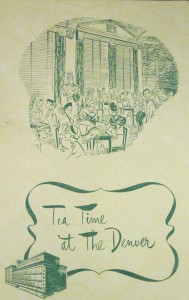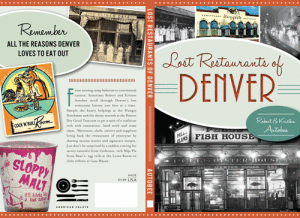Story
“The Elegant Things Have Vanished”: Dining at The Denver Dry Goods’ Tearoom
Lunch most days is an assault on the senses. Crumpled hamburger wrappers, your vehicle creeping toward the squawk of a broken speaker box in the drive through, and when it is all over the uncomfortable sense of “Did I just eat that?” Not that long ago, lunch was pleasant, the conversation was polite, and well-manicured ladies who went downtown to shop made time to have a little something during the middle of the day. For most of the last century, the first step toward a few moments of civilized serenity began with an elevator ride to the top floor of the Denver Dry Goods department store at the corner of 16th and California.
By the early 20th century, America’s department stores were private, for profit, enterprises. However, they also stood as symbols of civic pride – a mercantile landmark that survived by knowing and catering to the shopping desires of a particular community. Knowing what the customer wanted also extended to affairs of the stomach. In Chicago, Marshall Field’s offered Mrs. Herring’s Chicken Pot Pie. The Lazarus in Columbus, Ohio was known for its Cream of Cauliflower and Cheese Soup, and a trip to Atlanta’s Rich’s Department Store would be incomplete without a few bites of the Magnolia Room’s Frozen Fruit Salad.
In 1877, Michael J. McNamara opened the Drew & McNamara Dry Goods Company. Exactly three decades later in May 1907, Drew & McNamara was the Denver Dry Goods Company and management had just opened a room on the second floor offering light, yet tasty, afternoon teas in refined surroundings. By 1924, the tearoom was such a hit with Denverites that the Denver Dry launched a 4,000-square foot luncheon restaurant, still referred to as the tearoom, on the store’s fifth floor.
The Denver Dry – and other department stores – marketed primarily to women who liked to shop and eat. A glance at the cover of a tearoom menu from the 1950s captures an idealized rendering in pen and ink of a roomful of ladies in Chanel suits and smart hats engaging in witty small talk over Stuffed Tomato with Chicken salad (80 cents) or a toasted Fig and Nut sandwich (25 cents). All served by waitresses in starched white aprons, all with an uncanny sense of anticipating a diner’s every need.
The décor of the Denver Dry tearoom underwent a makeover once a decade. For two weeks in July 1962, management replaced the old furnishings with new draperies and chandeliers. Behind the scenes, the restaurant added $50,000 worth of ovens, refrigerators, and a conveyor belt dishwasher designed to handle the 9,000 dirty dishes and glasses a day. Many across metropolitan Denver suffered through a tough fortnight without a dish of Chicken a la King, a bowl of Navy Bean or Split Pea soup all topped off with a slice of Coconut Cream pie. Reopening with a new look on July 22, the Denver Post reported the tearoom was “Denver’s busiest restaurant with 500,000 customers a year, even though it’s open only one night a week and serves lunch but not breakfast.”
In 1966, the Denver trimmed the Dry Goods from its name for the sake of keeping up with the pace of the go-go decade. Known as “The Denver,” management added stores along the Front Range and in Montana over the next decade. The tearoom remained a welcome refuge in a city losing many of its late 19th century architectural treasurers to urban renewal. By the 1970s, the décor was green and white and the menu was brown and square and divided into what was on offer six out of seven days of the week. Friday’s “Waist Watcher’s Special” catered to Denver’s fitness conscious in the days when the city was just building its reputation as a mile high haven for joggers and cyclists. A dollop of protein with a thank you bite of carbohydrates was the order of the day as the special featured four ounces of beef liver with three ounces of parsley potatoes and a cup of fruit. All this for $2.90.
In the mid-1980s, the out-of-state conglomerate that owned rival May D&F devoured the region’s classiest merchandiser faster than a bratty kid attacking a “Doc’s Peach Cobbler.” The tearoom’s last lunch was almost eighty years to the day from its opening in 1907. On March 15, 1987, the kitchen prepared and staff served approximately 1,300 meals during the final 11 a.m. to 2:15 p.m. luncheon. Both Denver newspapers ran features filled with remembrances and recipes. A month later, the remaining Denver’s were either closed or absorbed by May D&F’s parent company, Associated Dry Goods. The tearoom last made headlines in 2007 when a local attorney purchased the fifth floor (referred to by the Denver Post as a “loft”) for $2.7 million.
A week before closing, a group of a long serving and loyal employees and retirees of The Denver met in the tearoom one last time. The walls and fixtures were now cream and blue, but the white linen tablecloths and silver tableware were all still in their familiar places. When asked to comment on what the end of this tradition meant, 82-year-old Helen Elliot captured the moment: “Many of the elegant things have vanished.”
The Denver Dry Goods did not invent tearoom dining, but the quality of its dishes, and the dignity of its surroundings, keeps its meals and atmosphere alive in the memories of many diners most days around noon.
(For more on Denver’s gone, but not forgotten, restaurants, please read Robert and Kristen Autobee’s Lost Restaurants of Denver.)


